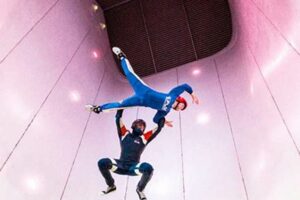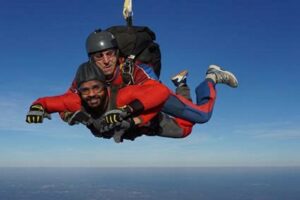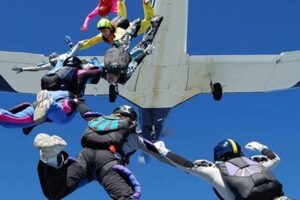Table of Contents
Skydive Height: Embracing the Thrill of Falling from the Heavens
Skydive height, the altitude from which a skydiver exits an aircraft, is a crucial factor that determines the duration of freefall, the speed of descent, and the overall skydiving experience. Whether it’s a heart-pounding jump from 10,000 feet or an exhilarating plunge from 18,000 feet, the choice of skydive height can cater to varying skill levels and thrill-seeking desires.
The significance of skydive height extends beyond the adrenaline rush. It plays a vital role in ensuring safety, allowing skydivers ample time to deploy their parachutes and navigate a smooth landing. Historically, skydiving evolved from military applications, where paratroopers exited aircraft at lower altitudes for tactical insertions. However, the advent of modern parachutes and advancements in skydiving techniques have enabled jumpers to ascend to greater heights, pushing the boundaries of the sport.
As we delve into the world of skydiving, this article will explore the various skydive heights, their impact on the skydiving experience, safety considerations, and the training required to conquer different altitudes. Get ready to take a leap into the extraordinary realm of skydiving, where the sky’s the limit.
Skydive Height
Skydive height, the altitude from which a skydiver exits an aircraft, encompasses various essential aspects that shape the skydiving experience.
- Altitude: The height above ground level.
- Duration: Time spent in freefall.
- Speed: Velocity of descent.
- Thrill: Level of excitement and exhilaration.
- Safety: Considerations for a safe jump.
- Experience: Skill level of the skydiver.
- Equipment: Parachutes, suits, and other gear.
- Training: Preparation required before a jump.
- Regulations: Rules and guidelines for skydiving.
These aspects are interconnected and influence each other. Higher altitudes provide a longer duration of freefall and a faster speed, intensifying the thrill. However, they also demand more experience, comprehensive training, and specialized equipment to ensure safety. Skydive height regulations vary across regions, considering factors like airspace restrictions and safety protocols. Understanding these aspects is crucial for skydivers to make informed decisions about their jumps, choose appropriate training programs, and prioritize safety while enjoying the exhilarating experience of skydiving.
Altitude
Within the realm of skydive height, altitude, or the height above ground level, stands as a pivotal factor that orchestrates the skydiving experience. It dictates the duration of freefall, the speed of descent, and the intensity of the thrill, making it a key consideration for both novice and seasoned skydivers.
- Jump Altitude: The altitude at which the skydiver exits the aircraft, typically ranging from a few thousand feet to over ten thousand feet.
- Freefall Time: The duration of the skydiver’s descent before deploying the parachute, directly influenced by the jump altitude.
- Terminal Velocity: The constant speed reached by the skydiver during freefall, determined by factors like body position and air resistance.
- Oxygen Levels: As altitude increases, oxygen levels decrease, requiring skydivers to breathe supplemental oxygen at higher altitudes.
These facets of altitude intertwine to create a multidimensional experience. Higher jump altitudes lead to longer freefall times, allowing skydivers to relish the exhilarating sensation of plummeting towards the earth. However, they also demand greater skill, specialized training, and meticulous safety precautions. Understanding the implications of altitude is paramount for skydivers to make informed decisions about their jumps, prioritize safety, and optimize their skydiving experience, whether seeking an adrenaline rush or a serene aerial journey.
Duration
Within the realm of skydiving, the duration of freefall holds a significant connection with skydive height, shaping the overall experience and presenting both opportunities and challenges.
Cause and Effect: Skydive height directly influences the duration of freefall. Higher jump altitudes result in longer freefall times, as the skydiver has a greater distance to descend before deploying their parachute. This extended freefall period amplifies the exhilarating sensation of plummeting towards the earth and provides more time to relish the breathtaking views.
Importance as a Component: Duration of freefall is a critical component of skydive height, as it determines the amount of time skydivers have to perform aerial maneuvers, experience the rush of freefall, and transition to a controlled descent. It is a defining factor that distinguishes different skydiving disciplines, such as freeflying, wingsuiting, and formation skydiving, each requiring specific durations of freefall for optimal performance.
Real-Life Examples: The relationship between skydive height and duration of freefall is evident in various real-life scenarios:
- A skydiver jumping from 10,000 feet may experience approximately 45 seconds of freefall before deploying their parachute.
- In high-altitude skydiving, jumpers exiting at 20,000 feet or above can enjoy freefall times exceeding 60 seconds.
- Professional skydivers performing complex aerial maneuvers may seek higher jump altitudes to extend their freefall duration.
Practical Applications: Understanding the connection between skydive height and duration of freefall has several practical applications:
- Skydivers can strategize their jumps to achieve desired freefall times, catering to their skill level and desired experience.
- Drop zones and skydiving centers consider prevailing wind conditions and airspace regulations to determine suitable jump altitudes that provide optimal freefall duration.
- Equipment manufacturers design parachutes and related gear to accommodate varying jump altitudes and freefall times.
In conclusion, the duration of freefall and skydive height are intricately linked, shaping the skydiving experience and influencing various aspects of the jump. Skydivers leverage this understanding to tailor their jumps, optimize performance, and ensure safety. This connection underscores the importance of comprehensive training, meticulous planning, and adherence to safety protocols to fully appreciate the exhilarating freedom of skydiving.
Speed
In the realm of skydive height, the velocity of descent, often referred to as speed, emerges as a captivating aspect that orchestrates the skydiving experience. It is the rate at which a skydiver plummets towards the earth, influenced by a multitude of factors and shaping the overall thrill and exhilaration of the jump.
- Terminal Velocity:
The constant speed reached by a skydiver during freefall, determined by factors like body position, air resistance, and equipment. As a skydiver reaches terminal velocity, their acceleration ceases, and they maintain a steady descent rate. - Body Position:
The skydiver’s body position significantly impacts their speed. A streamlined
, head-down position minimizes air resistance, allowing for higher speeds, while a spread-eagle position increases resistance, resulting in slower descent. - Equipment:
The type of equipment used, particularly the size and shape of the parachute, influences the skydiver’s speed. Larger parachutes generate greater air resistance, leading to slower speeds and a more controlled descent, while smaller parachutes facilitate faster descents. - Altitude:
Skydive height, or the altitude from which the jump is made, also plays a role in determining speed. Higher altitudes provide more time for the skydiver to accelerate and reach terminal velocity, resulting in higher speeds compared to lower altitudes.
These facets of speed intertwine to create a dynamic experience. Skydivers can manipulate their body position and equipment to achieve desired speeds, whether seeking an adrenaline-fueled descent or a more leisurely glide. Understanding the factors that influence speed is crucial for skydivers to make informed decisions about their jumps, prioritize safety, and optimize their skydiving experience.
Thrill
Within the realm of skydive height, the thrill experienced by the skydiver stands as a defining characteristic, shaping the overall intensity and enjoyment of the jump. This exhilarating sensation stems from the unique combination of physical and psychological factors that converge during a skydive.
- Height and Speed:
The sheer height from which a skydiver jumps, coupled with the resulting high speeds of freefall, generates an intense rush of adrenaline, amplifying the thrill factor. - Confronting Fear:
Overcoming the innate fear of heights and willingly stepping out of an aircraft requires courage and resilience, creating a sense of accomplishment and exhilaration. - Sensory Overload:
The skydive experience bombards the senses with an array of stimuli, including the wind rushing past, the breathtaking views, and the feeling of weightlessness, resulting in an overwhelming sense of exhilaration. - Adrenaline Rush:
The body’s natural response to the perceived danger of skydiving triggers a surge of adrenaline, leading to heightened arousal, increased focus, and an overall feeling of invigoration.
These facets of thrill are intricately intertwined, weaving together to create a symphony of excitement and exhilaration that is unique to the skydiving experience. The interplay between height, speed, fear, sensory overload, and the adrenaline rush orchestrates an emotional rollercoaster that leaves skydivers craving for more. As thrill-seekers continue to push the boundaries of skydive height, the pursuit of this exhilarating sensation remains an integral part of the sport’s allure.
Safety
In the realm of skydiving, safety stands as a paramount concern, intricately intertwined with the concept of skydive height. Understanding this connection is crucial for ensuring a thrilling yet controlled descent.
Cause and Effect: Skydive height directly influences the safety of a jump. Higher altitudes demand more time for equipment checks, oxygen management, and decision-making in the event of emergencies. Conversely, lower altitudes provide less margin for error, requiring meticulous attention to detail and swift responses.Critical Component: Safety considerations are a critical component of skydive height, as they dictate the parameters within which a jump can be executed safely. Factors such as weather conditions, equipment quality, and jumper experience must be carefully evaluated to determine an appropriate jump altitude.Real-Life Examples:
- Skydivers often opt for lower jump altitudes when training or practicing new maneuvers, prioritizing safety over the extended freefall time of higher jumps.
- In high-altitude skydiving expeditions, jumpers meticulously plan their jumps, incorporating oxygen tanks and specialized equipment to mitigate the risks associated with extreme altitudes.
Practical Applications:
- Drop zones and skydiving centers establish specific jump altitudes based on safety considerations, taking into account factors like airspace regulations, weather patterns, and the experience level of jumpers.
- Skydivers undergo rigorous training to develop the skills and knowledge necessary to assess and manage risks associated with different jump altitudes.
- Equipment manufacturers design parachutes and related gear to meet safety standards and accommodate the demands of various jump altitudes.
In summary, safety considerations and skydive height are inextricably linked, shaping the overall skydiving experience. By understanding this connection, skydivers can make informed decisions about jump altitudes, prioritize safety without compromising on exhilaration, and enjoy the sport responsibly.
Experience
Experience, epitomized by the skill level of the skydiver, is an indispensable factor intertwined with skydive height, dictating the safe execution and overall enjoyment of the jump. It encompasses various facets that determine a skydiver’s ability to navigate the complexities of high-altitude freefall.
- Training and Certification:
Formal training and certification programs equip skydivers with the necessary knowledge, skills, and techniques to safely execute skydives at various altitudes, ensuring proficiency in parachute deployment, emergency procedures, and aerial maneuvers. - Number of Jumps:
Accumulating jumps builds experience and familiarity with the physical and psychological demands of skydiving. As skydivers progress through different skill levels, they gain confidence and the ability to handle more challenging jump altitudes and maneuvers. - Comfort Level:
Personal comfort level plays a significant role in determining suitable jump altitudes. Skydivers should respect their limits and gradually increase jump heights as they gain experience and confidence, avoiding situations that exceed their skill level. - Specializations:
Skydiving encompasses various disciplines, each with unique skill requirements. Wingsuit flying, freeflying, and formation skydiving demand specialized training and experience to manage the complexities and risks associated with these maneuvers, often performed at higher altitudes.
Experience, encompassing these facets, serves as a cornerstone of skydiving safety and enjoyment. It empowers skydivers to make informed decisions about jump altitudes, choose appropriate training programs, and progress through skill levels at a pace that aligns with their abilities. Ultimately, experienced skydivers not only enhance their personal safety but also contribute to the overall safety and camaraderie within the skydiving community.
Equipment
In the realm of skydiving, the relationship between equipment and skydive height is of paramount importance, influencing the safety, performance, and overall experience of the jump.
Cause and Effect: Skydive height directly impacts the selection and use of equipment. Higher altitudes demand specialized gear designed to withstand the extreme conditions and provide reliable performance. For instance, high-altitude skydives require larger parachutes with slower opening speeds to ensure safe deployment at lower air densities. Additionally, oxygen systems and heated suits may be necessary to manage the physiological effects of high altitudes.
Critical Component: Equipment serves as a critical component of skydive height, enabling jumpers to safely navigate the challenges of high-altitude jumps. The quality, reliability, and suitability of parachutes, suits, and other gear play a crucial role in ensuring a successful and enjoyable experience. Without appropr
iate equipment, skydivers would be exposed to unacceptable risks, limiting the feasibility and enjoyment of high-altitude skydiving.
Real-Life Examples:
– High-altitude skydiving expeditions, such as those conducted by the Red Bull Stratos project, require custom-designed suits and parachutes capable of withstanding the extreme temperatures and low air pressure encountered at the edge of space.- Military and special forces personnel utilize specialized parachutes and equipment for high-altitude jumps, enabling them to perform covert insertions or precision landings.
Practical Applications:
– Skydiving equipment manufacturers continually innovate and refine their products to enhance safety, performance, and comfort at various altitudes.- Drop zones and skydiving centers maintain rigorous equipment inspection and maintenance protocols to ensure the reliability and safety of their gear.- Skydivers undergo comprehensive training on equipment selection, packing, and deployment techniques, empowering them to make informed decisions and execute safe jumps.
In conclusion, the connection between equipment and skydive height is inseparable, with each element influencing the other to ensure the safety and success of the jump. Skydivers rely on specialized equipment to conquer the challenges of high altitudes, pushing the boundaries of human flight while experiencing the exhilarating freedom of freefall.
Training
In the realm of skydiving, the connection between “Training: Preparation required before a jump” and “skydive height” is of critical importance, influencing the safety, proficiency, and overall experience of the jump. Understanding their relationship is paramount for skydivers to make informed decisions, prioritize safety, and push the boundaries of their abilities.
Cause and Effect: Skydive height directly influences the level and intensity of training required before a jump. Higher altitudes demand more comprehensive training to ensure skydivers possess the skills and knowledge necessary to navigate the challenges of high-altitude freefall. This includes specialized training in oxygen management, emergency procedures, and aerial maneuvers specific to high-altitude jumps.
Critical Component: Training serves as a critical component of skydive height, as it equips jumpers with the necessary skills and knowledge to safely execute jumps at various altitudes. Without proper training, skydivers would be exposed to unacceptable risks, limiting their ability to fully experience the exhilaration and freedom of high-altitude skydiving.
Real-Life Examples:
– Military and special forces personnel undergo rigorous training programs to prepare for high-altitude jumps, enabling them to perform complex insertions and maneuvers in challenging environments.
– Professional skydivers and BASE jumpers engage in extensive training to master advanced techniques and safely push the limits of the sport.
Practical Applications:
– Skydiving training programs are structured to progressively introduce skydivers to higher altitudes as they gain experience and demonstrate proficiency.
– Drop zones and skydiving centers offer training programs tailored to different skill levels and aspirations, ensuring skydivers receive the necessary instruction before attempting higher jumps.
– Skydivers continuously engage in ongoing training to maintain and enhance their skills, keeping up with evolving techniques and safety protocols.
In summary, the connection between training and skydive height is inseparable, with each element influencing the other to ensure the safety and success of the jump. Skydivers rely on comprehensive training to conquer the challenges of high altitudes, unlocking new levels of skill and pushing the boundaries of human flight.
Regulations
In the realm of skydiving, regulations serve as the cornerstone of safety, ensuring a structured and standardized approach to the sport. These rules and guidelines govern various aspects of skydiving, including skydive height, to safeguard participants and maintain the integrity of the activity.
- Licensing and Certification:
Skydiving regulations often mandate licensing and certification requirements for jumpers, ensuring they possess the necessary skills, knowledge, and experience to safely participate in the sport. This includes training in proper jumping techniques, equipment handling, and emergency procedures. - Altitude Restrictions:
Regulations may impose altitude restrictions for skydiving, particularly for less experienced jumpers or in specific airspace. These restrictions are in place to mitigate the risks associated with high-altitude jumps and ensure jumpers have sufficient time to deploy their parachutes safely. - Equipment Standards:
Skydiving regulations set forth standards for equipment used in the sport, including parachutes, containers, and other safety gear. These standards ensure that equipment meets okrelonych parametrw, undergo regular maintenance, and is properly packed and deployed. - Safety Procedures:
Regulations outline specific safety procedures that skydivers must follow before, during, and after a jump. These procedures cover pre-jump briefings, equipment checks, communication protocols, and emergency response plans. Adherence to these procedures minimizes risks and helps maintain a safe skydiving environment.
In conclusion, regulations play a vital role in skydiving, particularly in relation to skydive height. By establishing licensing requirements, altitude restrictions, equipment standards, and safety procedures, regulations create a structured framework that prioritizes the safety and well-being of skydivers while fostering a responsible and enjoyable skydiving experience.
Frequently Asked Questions about Skydive Height
This section addresses common queries and clarifies key aspects of skydive height to enhance your understanding of this thrilling activity.
Question 1: What factors determine the ideal skydive height?
The choice of skydive height depends on experience level, desired thrill, safety considerations, and regulations. Higher altitudes offer longer freefall times but demand more training and specialized equipment.
Question 2: How does skydive height impact the freefall experience?
Higher jump altitudes result in extended freefall times, providing more time to enjoy the exhilarating sensation of plummeting towards the earth. However, it also requires managing higher speeds and making timely parachute deployments.
Question 3: What safety considerations are associated with different skydive heights?
Higher altitudes demand specialized equipment, such as oxygen systems and heated suits, to mitigate the physiological effects. Skydivers must undergo comprehensive training to handle the challenges and emergencies that may arise at varying altitudes.
Question 4: How does training influence the choice of skydive height?
Training is paramount for skydivers to progress safely to higher altitudes. It equips them with the skills, knowledge, and decision-making abilities necessary to navigate the complexities of high-altitude freefall.
Question 5: What regulations govern skydive heights?
Regulations often impose altitude restrictions and licensing requirements to ensure jumper safety and maintain a structured skydiving environment. These regulations vary across jurisdictions and are subject to regular review and updates.
Question 6: How do I determine the appropriate skydive height for my first jump?
For first-time skydivers, lower altitudes are recommended
to prioritize safety and minimize potential risks. As experience and comfort levels increase, skydivers can gradually progress to higher jump altitudes.
In summary, skydive height is a multifaceted aspect of the sport that encompasses a range of considerations, including safety, experience, and regulations. Understanding these factors enables skydivers to make informed decisions about their jumps and enjoy the thrilling experience of skydiving responsibly.
As we delve further into the realm of skydiving, we will explore additional aspects that contribute to the overall experience, such as equipment selection, training programs, and the physical and psychological demands of the sport.
Skydive Height Tips
The TIPS section provides valuable insights and practical advice for skydivers of all experience levels to optimize their jumps, prioritize safety, and maximize enjoyment.
Tip 1: Assess Your Experience:
Before attempting higher jumps, ensure you have sufficient training, experience, and comfort at lower altitudes. Progress gradually to build confidence and skills.
Tip 2: Choose the Right Equipment:
Invest in high-quality equipment, including a well-fitted parachute, reliable altimeter, and sturdy jumpsuit. Regular maintenance and inspections are crucial.
Tip 3: Train with Professionals:
Enroll in reputable skydiving schools and seek guidance from experienced instructors. Comprehensive training enhances your skills, knowledge, and decision-making abilities.
Tip 4: Understand Weather Conditions:
Familiarize yourself with the weather forecast and prevailing wind patterns before your jump. Favorable conditions contribute to a safe and enjoyable experience.
Tip 5: Practice Emergency Procedures:
Master emergency procedures, including parachute malfunctions and freefall emergencies. Regular practice instills confidence and prepares you to respond effectively in challenging situations.
Tip 6: Listen to Your Body:
Pay attention to your physical and mental state before and during your jump. If you feel unwell or anxious, communicate with your instructors and consider rescheduling your jump.
Tip 7: Enjoy the Experience:
While safety is paramount, don’t forget to embrace the thrill and exhilaration of skydiving. Take in the breathtaking views, feel the rush of freefall, and savor the unique experience.
By following these tips, skydivers can enhance their safety, maximize their enjoyment, and progress confidently in the sport.
In the concluding section of this article, we will delve into the psychological aspects of skydiving, exploring how mental preparation, emotional regulation, and overcoming fear contribute to a successful and fulfilling skydiving experience.
Conclusion
This comprehensive exploration of skydive height unveiled a intricate tapestry of factors that orchestrate the skydiving experience. Key insights emerged, highlighting the profound impact of altitude on various aspects of the jump, including the duration of freefall, the speed of descent, and the intensity of the thrill. Furthermore, the article emphasized the critical role of training, experience, equipment, and safety regulations in ensuring responsible and enjoyable jumps.
- Altitude and Experience: Skydive height directly influences the duration of freefall and the overall thrill, catering to different skill levels and risk appetites. However, higher altitudes demand meticulous training, specialized equipment, and a deep understanding of safety protocols.
- Training and Equipment: Comprehensive training empowers skydivers with the skills and knowledge necessary to navigate the challenges of high-altitude jumps. Specialized equipment, regularly inspected and maintained, further enhances safety and enables jumpers to fully embrace the exhilaration of skydiving.
- Safety and Regulations: Stringent safety regulations, including altitude restrictions and licensing requirements, provide a structured framework for skydiving. These regulations prioritize jumper safety, ensuring that skydivers possess the requisite expertise and equipment to safely execute jumps at varying altitudes.
The realm of skydive height invites thrill-seekers to transcend their limits, pushing the boundaries of human flight. It is a testament to human ingenuity and our insatiable desire to explore the unknown. As we continue to refine our understanding of skydiving science and safety, the future of this exhilarating sport holds limitless possibilities for adrenaline enthusiasts worldwide.







